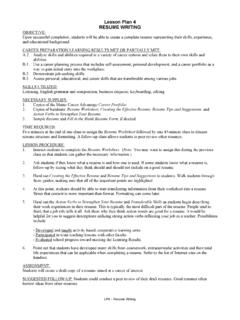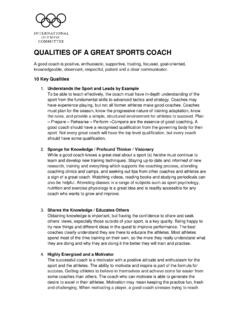Transcription of Tee Ball Practice Plans and Drills - Truckee Little League
1 Tee ball Practice Plans and Drills Introduction: Whether you are a parent whose child is about to start Tee ball for the first time or you are about to take on the responsibility of coaching a Tee ball team, this guide can provide valuable information to prepare you for the season. The key to successful coaching is being prepared and organized. It is important to take advantage of the limited time you get each week with the players. Being organized before you arrive at Practice , and having a structured Practice schedule with help you stay on track. We'll present a handful of fundamentals and Drills . You'll need to outline the key Drills you'll run during Practice . Having a list of Drills designed to improve fundamentals and provide game time situations will allow you to make the most of your time. The goal for the season should be to teach every player their positions and the game of baseball (Tee ball ).
2 Things may look disorganized during the first couple of weeks. If you are patient and consistently coach the players your games can become competitive and the experience for everyone will be enjoyable. Coaching youth sports can be challenging. With some guidance and organization your experience can be extremely rewarding. This Tee ball guides has been designed for T- ball . These Drills have been used successfully and were created so the coach can effectively communicate and the players can easily understand. Included are organized batting, throwing, catching and fielding Drills along with suggested Practice Plans . The Plans were created to keep the kids interested and provide a positive learning experience. Each page consists of Drills and techniques to run your Practice . Recommendations: The Drills are in order of difficulty. I recommend teaching a couple Drills at a time. The most important thing is focus on the proper form of each drill and do not lose sight of the fundamentals of the game.
3 Coaching tips : 1. Prepare for Practice before you arrive to the baseball field. Once you arrive at the Practice location, you will be bombarded with kids, parents, other coaches , along with the task of setting up. Once you arrive, you will not have time to prepare activities, Drills , etc. 2. Be clear of the goals and expectations of the day and season. coaches quite often will assume that every player understands what they are supposed to do, and how they're supposed to act. Be sure to state the Plans for the day and expectations as Practice starts. This is also important to address at the beginning of the season when addressing the coaches , players and parents. 3. Ask for help. Be sure to invite others to be assistant coaches . This will be valuable for practices and games. The players will enjoy there experience and will get better instruction, if they can split up into small groups to run the Drills .
4 I recommend having a total of 4 coaches . One head coach and 3 committed assistant coaches . 4. Keep the Practice moving. Many coaches like to talk (too much). Depending upon the age group kids typically have a short attention span and will lose interest. Be prepared to quickly explain the drill and then get it started. The more the kids are moving to various stations, the less likely you'll have to deal with other issues. 5. Focus on the fundamentals. Always keep player development at the top of the priority list. Many coaches play to win, and often forget they have 12 kids on the team. If you work to develop every kid by the end of the year your team will be better prepared than others. If each player leaves the season better than when they arrived, you have succeeded. 6. Encourage effort. Practice is Practice . The kids are going to make many mistakes, some more than others. The players will be trying new things and advancing in there development at different paces.
5 The one thing they can all be good at is EFFORT. This will instill confidence in the players and provide them with a base for getting better. 7. Don't worry about the small things. Kids will be kids. There is nothing you or I will do to ever change that. There should be certain guidelines for conduct, but kids being kids is going to happen. Set basic guideline, and reinforce during Practice . 8. coaches are there for the kids, the kids aren't there for the coaches . If you missed you chance to play pro ball , coaching youth baseball is not the replacement. 9. coaches are role models. Remember to always talk positive about players, parents, other teams, and coaches . Kids look up to the coach, so it's important to provide them with a positive image. What we say, how we say it, and how we act can leave a lasting impression on a young player. Always be positive, even on those days that seem most challenging.
6 10. Have Fun! Coaching kids should be enjoyable. Try to have fun, and keeps the season in perspective. Practice Plans #1 (based on 60 minute Practice ). 10 minutes Warm Up it is important to start each Practice with a warm up. This provides the foundation for an organized Practice and gets the players prepared to start the day. Spread out with enough room to do an exercise. Lite stretching exercises touch touches, hip rotations, arm circles, etc. Calisthenics exercises jumping jacks, high knees, etc Lite jog around the baseball field to conclude 27 minutes Station Drills (focused on the fundamentals). Divide the team into three groups (if possible). Rotate every 9 minutes. Station 1 - Hitting (see list of Drills ). Station 2 - Fielding - Infield/Outfield (see list of Drills ). The first couple practices should be focus on infield only. After a couple practices introduce the outfield, and start to combine infield and outfield into Practice ( throwing to 2nd base, backing up 1st base, etc.)
7 Station 3 Throwing/Catching (see list of Drills ). 3 minutes - Water break 20 minutes Batting & Infield Practice Team takes the field in various position 10 pitches per player run on final ball . Rotate players in to bat. Recommendation - 3 players batting (remainder in the field). Although this is batting Practice , the fielders should be taught the make the correct play batted ball End - Water break/closing comments Practice Plans # 2 (based on 90 minute Practice ). 10 minutes Warm Up it is important to start each Practice with a warm up. This provides the foundation for an organized Practice and gets the players prepared to start the day. Spread out with enough room to do an exercise. Lite stretching exercises touch touches, hip rotations, arm circles, etc. Calisthenics exercises jumping jacks, high knees, etc Light jog around the baseball field to conclude 30 minutes Stations Drills - focused on the fundamentals.
8 Divide the groups into to three stations - Rotate every 10 minutes Station 1 - Hitting - see hitting Drills Station 2 - Fielding (Infield/Outfield) see fielding Drills Start with the infield through a few practices and then teach the outfield. As you progress through out the year then incorporate both into the session. Example - Throwing into the second base, backing up first base, etc). Station 3 Throwing/Catching see list of Drills 5 minutes Water break between rotations 20 minutes Infield Practice /Outfield Practice Players take their positions coaches hit balls to various positions Important to call out situations and options for the players. (plays at first, second, etc). 25 minutes Batting and infield Practice Team takes the field in various position 12 pitches per player run on final ball . Rotate players in to bat. Recommendation - 3 players batting (remainder in the field). Although this is batting Practice , the fielders should be taught the make the correct play batted ball End - Water break/closing comments The Basics of Tee ball Learning the Positions: Walk each player to their position Start with 1st Base, 2nd Base, Short Stop, 3rd Base, Pitcher, and Catcher Discuss important points of each position.
9 Communicate name of each base and position Where the actual position stands in relation to the base Area to cover when ball is hit. Boundaries to cover Over emphasis to only cover their area. Important factors to teach as the year progress What to do if ball is hit to their position. (Assume the play is throw to first base other situations will come later). What to do if the ball is not hit to the player. What do they do? Where should they go? Importance of always paying attention to the batters and runners Return back to position after each play. Discuss backing up other positions when ball is in play Where to go when runners are running When to hold the ball Discuss the basic concept of baseball: Team on Defense Team in the field Objective is to stop the batting team from scoring runs. Various ways to get outs Team on Offense Team batting Objective is to hit the ball so the defense can't get Get to the bases before the defense gets you out Importance to running fast to the bases, and staying on the base Review basic rules (including local League rules) that are specific to your League Fielding Technique and Practice Drills Proper stance: Feet shoulder width apart Knees bent - weight should be forward on the balls of feet Their head is up facing the ball .
10 Keep eyes on the ball until ball is in the glove. Proper glove/hand position: Glove hand should just be touching the dirt at a 45 degree angle. Throwing hand should be above the glove with the palm facing the ball . Once the ball reaches the glove the top hand should cover the ball inside the glove. Infield Grounder Drills Basic Grounder Drills Form one line just behind shortstop position Have one player at a time step up into the SS position. Roll grounders to the player and have them field ball and throw back to you. Emphasis the importance of proper stance, keeping glove on the ground, and making a quick but accurate throw back. Side to Side Grounder Drills Same as Basic but roll the balls left and right of the player to make him move to get in front of the ball . Emphasis the importance of moving to get in front of the ball instead of reaching out with the glove. Infield Grounder Drills (continued).






